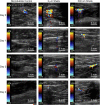Hollow silica and silica-boron nano/microparticles for contrast-enhanced ultrasound to detect small tumors
- PMID: 22498299
- PMCID: PMC3588157
- DOI: 10.1016/j.biomaterials.2012.03.066
Hollow silica and silica-boron nano/microparticles for contrast-enhanced ultrasound to detect small tumors
Abstract
Diagnosing tumors at an early stage when they are easily curable and may not require systemic chemotherapy remains a challenge to clinicians. In order to improve early cancer detection, gas filled hollow boron-doped silica particles have been developed, which can be used for ultrasound-guided breast conservation therapy. The particles are synthesized using a polystyrene template and subsequently calcinated to create hollow, rigid nanoporous microspheres. The microshells are filled with perfluoropentane vapor. Studies were performed in phantoms to optimize particle concentration, injection dose, and the ultrasound settings such as pulse frequency and mechanical index. In vitro studies have shown that these particles can be continuously imaged by US up to 48 min and their signal lifetime persisted for 5 days. These particles could potentially be given by intravenous injection and, in conjunction with contrast-enhanced ultrasound, be utilized as a screening tool to detect smaller breast cancers before they are detectible by traditional mammography.
Copyright © 2012 Elsevier Ltd. All rights reserved.
Figures







References
-
- Klimberg VS, Harms S, Korourian S. Assessing margin status. Surg Oncol. 1999;(2):77–84. - PubMed
-
- Mullenix PS, Cuadrado DG, Steele SR, Martin MJ, See CS, Beitler AL, et al. Secondary operations are frequently required to complete the surgical phase of therapy in the era of breast conservation and sentinel lymph node biopsy. Am J Surg. 2004;187(5):643–6. - PubMed
-
- Singletary SE. Surgical margins in patients with early-stage breast cancer treated with breast conservation therapy. Am J Surg. 2002;184(5):383–93. - PubMed
-
- Gray RJ, Salud C, Nguyen K, Dauway E, Friedland J, Berman C, et al. Randomized prospective evaluation of a novel technique for biopsy or lumpectomy of nonpalpable breast lesions: radioactive seed versus wire localization. Ann Surg Oncol. 2011;8(9):711–5. - PubMed
-
- Gray RJ, Pockaj BA, Karstaed PJ, C.Roarke M. Radioactive seed localization of nonpalpable breast lesions is better than wire localization. Am J Surg. 2004;188(4):377–80. - PubMed
Publication types
MeSH terms
Substances
Grants and funding
LinkOut - more resources
Full Text Sources
Other Literature Sources

